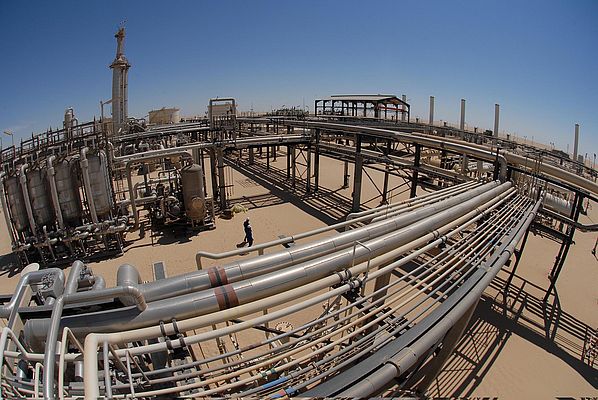Wintershall, a subsidiary of BASF, has switched from a diesel-driven power plant to a gas turbine with a synchronous generator to supply electricity to its gas/oil separation plant (GOSP) at the Nakhla site in the Libyan Desert. The custom synchronous generator, including a matching instrumentation and control package, was supplied by international drive specialist WEG.
The result is an autonomous power plant that uses associated gas from the GOSP, reducing environmental impact and boosting plant availability. Wintershall, Germany's largest global petroleum and natural gas producer, has been active in oil exploration and processing in Libya since 1958. Today the company operates in the Libyan Desert 1,000 km south of the capital city Tripoli with eight onshore oil fields in the C 96 and C 97 concessions. Wintershall also has a share in production from the Al Jurf offshore platform off the north-west coast and holds a licence for another exploration area in the south-eastern region of the country.
One of the largest extraction companies in the North African country, Wintershall produces up to 90,000 barrels a day and 30 million barrels a year at full capacity. The company also acts as a technology leader in the local exploration and production (E&P) sector. Rather than flaring off associated gas from oil extraction, which is common practice, Wintershall pursues a "no flaring" policy and processes the gas extensively, thereby significantly reducing CO2 emissions in Libya.
Utilising available energy
Wintershall's energy demand rose at its Nakhla and Hamid site after to the introduction of a water injection process. Prior to the modernisation measures at the Nakhla GOSP site in 2009, the only way to meet the Hamid plant's diesel fuel demand of approximately 40,000 litres per week was by truck. With thousands of kilometres travelled each year, truck transport was costly and it was also accompanied by the risk of accidents. As supply depended on trucks, there was also a latent risk of a power outage if a truck did not arrive on time, which would result in a costly production shutdown. Rather than upgrading the old, remote diesel power plant at the Hamid site, Wintershall decided to centralise electricity generation in the GOSP at the Nakhla site, just 26kms away, in order to use the associated gas available there for electricity generation. The solution was a new high-performance gas turbine with a rated power of 7 MW equipped with a WEG synchronous generator.
Due to the harsh environmental conditions, including high temperatures and frequent sandstorms, there were stringent requirements from the electrical equipment. For example, formation of sand deposits in the generator must be prevented and fine sand particles, which can penetrate even the smallest cracks, must be removed immediately to prevent damage. Additionally, due to the remote location of the site, spare parts are not readily available and all building materials must be transported to the site (mixing concrete from materials at the site is not possible because the sand is too salty). In order to face all these challenges, Wintershall chose WEG's robust and reliable generators. With a capacity of 10.2 MVA, WEG's synchronous generator runs autonomously and has already run for more than 20,000 hours in continuous duty. A custom model, the generator took approximately one year to build and one of its special features is air cooling with a top-mounted air/air heat exchanger and external fans. The air filter is designed to prevent sand accumulation, with all sand particles fed out directly through slits. Additionally, the four-pole generator - with IP55 protection rating - is designed for a voltage of 6,000 V at a frequency of 50 Hz and for temperatures of up to 55°C and is painted white to minimise heat absorption.
A 30 kV overhead line connecting Nakhla to the diesel power plant at the Hamid site was constructed to provide power supply redundancy. The GOSP can now be operated from the gas turbine and generator or from the conventional diesel power plant in case of emergency. The 14 MW of surplus heat from the gas turbine is now used to heat the extracted oil up to 70°C in place of five hot water boilers. "High operational reliability and availability were our main concerns when selecting the generator," explained Rainer Bleich, project manager at Wintershall. "In part that's because electricity generation is vital for the continuous operation of our GOSP in Nakhla - every day of downtime can cost us millions of euros. In addition, the lead time for that kind of custom-made generator can be as much as 18 months from initial design to commissioning, and it takes at least two to three days for external fitters to reach the site if repairs are needed."
Many benefits from just one generator
Since switching to the gas turbine and synchronous generator solution, Wintershall has experienced significant benefits. The most important of these is the site's improved operational security with reliable, autonomous and redundant electricity generation. In addition, the new generating system requires much less maintenance than the previous diesel power plant. Moreover, accident-prone and costly diesel fuel truck transport is now only necessary in case of emergency. As a result, diesel fuel consumption has dropped significantly, leading to cost savings and reduced CO2 emissions. Surplus heat is also used productively to heat the crude oil.
"This project is not the only successful collaboration with Wintershall in Libya," says Andreas Schulte Mesum, Director for Energy Products at WEG Germany. "Two synchronous generators with a similar design are also in use at the Jakhira site. One of them is also integrated with a gas turbine for electricity generation, and the other serves as a backup generator. "Our generators are particularly suitable for replacement situations because our high degree of vertical integration enables us to adapt very flexibly to individual customer requirements. The replacement generator in Jakhira, for example, has different couplings for the shafts and adapter plates for installation, allowing a single generator model to be used to replace two different types of generator."
























































